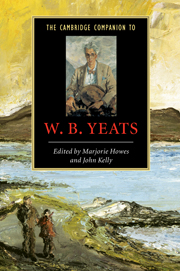Book contents
- Frontmatter
- 1 Introduction
- 2 Yeats and Romanticism
- 3 Yeats, Victorianism, and the 1890s
- 4 Yeats and Modernism
- 5 The later poetry
- 6 Yeats and the drama
- 7 Yeats and criticism
- 8 Yeats, folklore, and Irish legend
- 9 Yeats and the occult
- 10 Yeats and gender
- 11 Yeats and politics
- 12 Yeats and the postcolonial
- Bibliography
- Index
9 - Yeats and the occult
Published online by Cambridge University Press: 28 January 2007
- Frontmatter
- 1 Introduction
- 2 Yeats and Romanticism
- 3 Yeats, Victorianism, and the 1890s
- 4 Yeats and Modernism
- 5 The later poetry
- 6 Yeats and the drama
- 7 Yeats and criticism
- 8 Yeats, folklore, and Irish legend
- 9 Yeats and the occult
- 10 Yeats and gender
- 11 Yeats and politics
- 12 Yeats and the postcolonial
- Bibliography
- Index
Summary
Suppose, by some miracle or other, the essence of Yeats could be expressed in an image or figure. If by a further miracle we could ask him, Yeats would doubtless approve of such a speculative project, which would fit with his famous notion that a poet “is never the bundle of accident and incoherence that sits down to breakfast; he has been reborn as an idea, something intended, complete” (E&I 509). It would make sense for this idea to be imaginary rather than denotative, since Yeats's work from start to finish suggests the pre-eminence of what can be envisioned over what can be rationally explained. In a letter written a few weeks before his death, Yeats sounded a note of finality: “It seems to me that I have found what I wanted. When I try to put all into a phrase I say, 'Man can embody truth but he cannot know it'” (L 922). Thus, as he had asserted several years earlier, in an essay on Shelley's Prometheus Unbound, “the ultimate reality is not thought, for thought cannot create but 'can only perceive'”; rather, “the created world is a stream of images in the human mind” (E&I 419). A human being who embodied truth would also, presumably, take the form of an image or symbol. Yeats arrived early at this fundamentally religious conviction and kept it throughout his long and much changing career. Another essay on Shelley, written over three decades before the one quoted above, makes the connection between image and the soul clearly. Shelley, Yeats writes, “could hardly have helped perceiving that an image that has transcended particular time and place becomes a symbol, passes beyond death, as it were, and becomes a living soul” (E&I 80). Not only are people expressible through images; symbols, like emotions and ideas, may be vitalized into living beings, if of a sort that transcend mortal comprehension. Yeats regularly intertwines art and what might for lack of a better term be called religion in just such outlandishly direct ways.
- Type
- Chapter
- Information
- The Cambridge Companion to W. B. Yeats , pp. 144 - 166Publisher: Cambridge University PressPrint publication year: 2006
- 4
- Cited by



